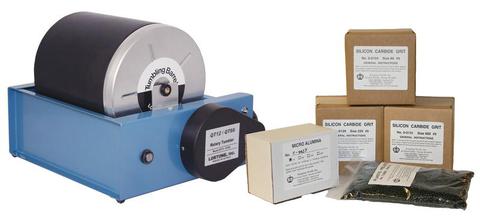A rotary rock tumbler is the most popular and least expensive type on the market today. It has a system of durable rubber barrels that rotate around a metal cylinder to tumble and polish the rocks inside. They are easy to use and create smooth, polished stones in 4-6 weeks. Finished rocks will have a rounded shape regardless of what they looked like when you started. Some models have multiple barrels so you can tumble two different types of rock, or process two batches at different stages of the tumbling process. The opposite type is called a vibrating rock tumbler.

Even though all tumblers do the same basic job, the size can affect your results. Not only do larger rock tumblers require more rock to operate efficiently, they also consume more grit and polish. Buy a small tumbler if you are just getting started or plan to tumble smaller loads. Buy a mid-size tumbler if you need to tumble larger stones (2-2.5 inches) or have larger amounts. Most tumblers are rated by weight capacity.
For example, a Lortone 3-pound rock tumbler will rotate three pounds of weight indefinitely. To polish rocks that measure 1.5 inches in diameter or larger, choose a rock polisher with at least a 6-pound capacity. To polish smaller stones, a three-pound capacity tumbler will work very well. Also follow these tips:
- Make sure the rough stones are all the same hardness, but are various sizes. Tumbling different sizes of rough in the same batch produces better results than tumbling rock of a single size. Don't use rocks that are cracked, have deep voids or have extremely irregular shapes.
- The barrel must always be at least 1/2 full for the tumbler to operate properly. Be careful not to overload your machine or the motor will burn out. Barrels more than 3/4 full (including grit and water) may not allow enough tumbling room inside, and may be too heavy and burn out the motor. A 3 pound tumbler has a motor designed to tumble a barrel that weighs up to 3 pounds. Weigh your barrel after adding the water if you are not certain. About four pounds of tumbling rough and coarse grit are the perfect load for a six pound tumbler barrel.
- Clean the inside and outside rims of the barrel and the edges of the lid carefully. Make sure the surfaces that will form the seal are clean and dry. Then place the lid on the barrel and seal the barrel. Put the barrel on the tumbler and start the motor.
- If the barrel ever leaks, stop the machine, remove the lid and re-clean the surfaces of the lid and barrel that make the seal. Double-check that they are clean and dry. Replace the lid securely and proceed.
- If you have a double-barrel tumbler, you might need both barrels loaded for the tumbler to function properly. Fill both barrels with batches of coarse grind of the same hardness so that they can be combined later on. One barrel can then run a batch of fine grind while the other prepares more rough.
- Do not pour used grit or slurry don't the drain! Discard in the trash instead.
Selecting Beach Pebbles for Your Rock Tumbler
One of the reasons people buy their first rock tumbler is so that they can try to recapture the beauty of sea-wet stones that they saw on a beach during their vacation. If you will be traveling to a beach or live near one, collecting beach pebbles to take home and tumble would seem like a real advantage over buying tumbling rough. After all, the surfaces have been rounded and smoothed by the waves into pleasing shapes, and it looks as if the first step in tumbling— rough grinding to round down the sharp edges— has already been done by Mother Nature. There are two things to watch out for, though.
The first is that sand and wave action can smooth granite or sandstone to the point where it looks polished when wet. The process can't be taken any further. Leave these coarse-grained stones on the beach for others to admire since these two materials don't do well in a rock tumbler. The outside of pebbles can be deceiving, so you may have to break a few open to find out for sure what it's made of.
The second is the tendency to collect large pebbles that are roughly the same size and shape. This is not what you really want to do because successful tumbling requires a variety of sizes of rocks to go in the same batch.
Treat beach pebbles as you would any other material. Select them on the basis of interesting color or pattern and make sure they are made of the same material, or at least the same hardness. Beaches on the Atlantic and Pacific coasts are where you are most likely to find semiprecious stones like jasper. Agates are also common. If you visit those places and have good luck beach combing, all you will have to do is finish what the first tumblers— the waves— have begun. Browse Lortone Rock Tumblers and supplies here.






